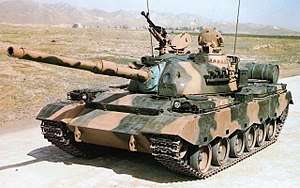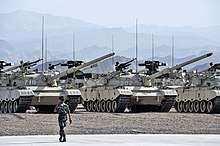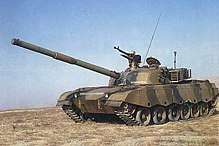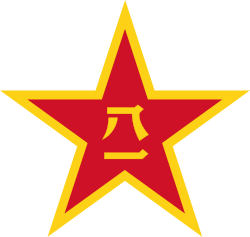Type 80/88 main battle tank
| Type 80 | |
|---|---|
 Type 80 with 105mm rifled gun | |
| Type | Main battle tank |
| Place of origin | People's Republic of China |
| Service history | |
| In service | 1980–2005 (China) |
| Used by | See Operators |
| Production history | |
| Designed |
1970s (Type 80) 1981–1987 (Type 88) |
| Manufacturer | First Inner Mongolia Machinery Factory |
| Variants |
Type 80/80-II Type 85/85-I/85-II/IIA/IIM/AP Type 88A/B/C |
| Specifications | |
| Weight | 38–39.5 tonnes |
| Length | 6.325 m (10.369m gun forward for Type 85-III) |
| Width | 3.372 m |
| Height | 2.29 m |
| Crew | 4 (3 in Type 85-IIA/Type 88C) |
|
| |
| Armor |
Type 80: Cast Steel Turret Type 85II/Type 88: Welded Steel/Composite Armor Turret. May be fitted with Explosive Reactive Armor |
Main armament |
Type 80/85: 105mm Type 83 or 83-I rifled gun Type 85IIA/Type 88C: 125mm smoothbore gun |
Secondary armament |
7.62 mm coaxial machine gun 12.7 mm air-defence machine gun |
| Engine |
12150L-7BV diesel 730 hp (544 kW) [1] |
| Power/weight | 18.5-19 hp/tonne |
| Transmission | Mechanical, planetary |
| Suspension | Torsion bar |
Operational range | 430 km, 600 km with external fuel |
| Speed | 57.25 km/h [1] |
The Type 80 (Chinese: 80式; pinyin: Bālíng Shì) and the Type 88 (Chinese: 88式; pinyin: Bābā shì) are a family of Chinese second-generation main battle tanks (MBTs). They are also known as the ZTZ80 and ZTZ88.
History
In the 1970s China's primary MBT in service was the Type 59, a copy of the T-54 tank which was obsolete compared to contemporary Soviet and Western designs. The People's Liberation Army (PLA) thus requested new tanks that could match Russian designs, which led to the development of the Type 69 tank that incorporated some technologies from a captured Soviet T-62 tank. However the Type 69 failed to satisfy PLA requirements and was only an export success that saw limited domestic service.
Further tank development commenced which led to the WZ122, Type 80 and Type 90 prototypes. The Type 80 began development in 1980 under 617 Factory with 201 Institute, 447 Factory, and 616 Factory.[2] None of the prototypes entered service.
A brand new tank was designed for export based on the Type 80 chassis. It was named the Type 85 and marketed as the "Storm". However, the Storm series of tanks failed to gather interest among potential buyers. From the Type 85-IIA onwards, the tank featured an expanded, angular turret with a copy of the T-72's 125mm gun with autoloader. The Type 85-IIM vairant eventually caught the interest of the Pakistani government and was exported under the designation Type 85-IIAP.
The Type 85-III was renamed the Type 88C for domestic production.[3] The Type 88C was renamed as the Type 96 and upgraded in the 1990s.
Design
The Type 80 inherited the design philosophy of the Type 69/79 which combined a Soviet style chassis and turret with Western technology. Like the Type 69 series, the initial Type 80 design possessed a hemispherical turret similar to the T-54/55. Another similarity was that the driver sat in the left forward section of the hull.[4] However, the Type 80 used a local copy of the NATO 105mm rifled gun instead of the Soviet 100mm rifled gun. It was also the first Chinese design to be observed using a system of six road wheels and three support rollers.[4] The first Chinese tanks to incorporate applique composite armor were later variants of the Type 80 family.[5]
The Type 85-I (Storm-1) series had a new welded turret design that was angular instead of the familiar bowl-shape. The Type 85IIAP/M was the first tank in the series to equip a 125mm smoothbore gun.
Variants
The Type 80 and 85 series were prototypes for export while the Type 88 series was for domestic use. Export tanks are designated with the "II" and/or "M" suffix.[6][7]
Type 80
Type 88

- Type 88 - Based on Type 80 design. Front storage racks on turret removed to fit explosive reactive armor (ERA) plates.
- Type 88A - Improved 105mm rifled gun. Could be fitted with ERA plates.
- Type 88B - Type 88A with a different smoke discharger configuration and JSFCS-212.[8] Used in a training unit in Beijing.
- Type 88C - Domestic version of Type 85-IIM. [3] Later known as Type 96. Gun upgraded to a copy of the T-72's 125mm smoothbore cannon. JSFCS-212 fire control system with laser rangefinder, ballistics computer, stabilized gunner's sight and dual-axis gun stabilization. 889b radio with range of up to 30 km.[9] Upgraded to Type 96A standard in the early 2000s.[6]
Type 85
- Type 85-I - Prototype with Type 80-II chassis, welded turret and 105 mm rifled main gun. Also known as Storm-1(Chinese: "风暴"1). None sold.[5]
- Type 85-II - Equipped with new locally produced 105mm gun.[10] Engine power upgraded from 730 horse power(HP) to 800. Also known as Storm-2(Chinese:"风暴"2). None sold.[5]
- Type 85-IIA/Type 85-IIM - Prototype with Type 80-II’s chassis and the Type 85-II’s turret. Early versions had poor reliability.[11] Combat weight of 41 tons. Upgraded to 125mm gun with autoloader which reduced crew to 3.[6] Pakistan ordered several hundred Type 85-IIAP ("P" signifying Pakistan).
- Type 85-III - Prototype with 1000 hp engine and the T-72's transmission system.[5] Included composite armor in the turret and ERA panels.[11][3]
- Storm-1/Type 85-I. Prototype designation for export. Never mass-produced. Welded turret on Type 80 chassis.
 Type 85-IIM variant with 125mm gun
Type 85-IIM variant with 125mm gun Type 85-ІІІ
Type 85-ІІІ
Operators






See also
Tanks of similar era
Tanks of similar performance
References
- 1 2 http://www.people.com.cn/GB/junshi/192/8559/8563/20020716/777241.html
- 1 2 "Type 88 Main Battle Tank - SinoDefence.com". 2010-06-07. Archived from the original on June 7, 2010. Retrieved 2015-11-03.
- 1 2 3 Pike, John. "Type 85-III / Type 88C". www.globalsecurity.org. Retrieved 2017-08-06.
- 1 2 3 4 5 "Type 80". www.globalsecurity.org. Retrieved 2015-11-03.
- 1 2 3 4 "中国坦克专家谈"外贸"坦克发展". www.huaxia.com. Retrieved 2015-11-07.
- 1 2 3 4 Blasko, Dennis J. (2012). The Chinese army today : tradition and transformation for the 21st century. Abingdon, Oxford: Routledge. p. 152. ISBN 9780415783217.
- ↑ "Type 85 Main Battle Tank - SinoDefence.com". 2013-06-01. Archived from the original on June 1, 2013. Retrieved 2015-11-06.
- ↑ "网友拍摄的北京郊外的88B坦克". wwbbs.tiexue.net. Retrieved 2017-04-21.
- ↑ "中国陆军88C式坦克". www.people.com.cn. Retrieved 2015-11-07.
- ↑ "Type 80". www.globalsecurity.org. Retrieved 2015-11-06.
- 1 2 Worldwide Equipment Guide 1 (2011 ed.) Ground Systems. US Army TRADOC Intelligence Support Activity. pp. 5–45.
- ↑ John Pike. "Pakistan Army Equipment". Globalsecurity.org. Retrieved 6 March 2013.
- 1 2 B., David (12 November 2015). "Type 85 MBT". Tank Encyclopedia. Archived from the original on 27 July 2017. Retrieved 27 July 2017.
- ↑ Binnie, Jeremy; Cranny-Evans, Samuel (27 July 2017). "Ugandan president reveals T-90 and Chinese tanks". IHS Jane's 360. Archived from the original on 27 July 2017. Retrieved 27 July 2017.
- ↑ Museveni, Yoweri (23 July 2017). "Presided over a combined arms exercise of the Land Forces and Air Defence of the SFC at Karama Armoured Warfare Training School in Kabamba". Twitter. Kabamba. Archived from the original on 27 July 2017. Retrieved 27 July 2017.
External links
- 88B Main Battle Tank photo and details
- Type 80/88 Main Battle Tank - GlobalSecurity.org
